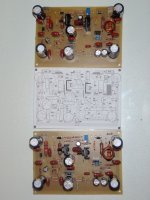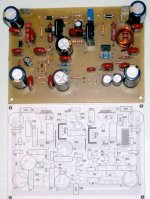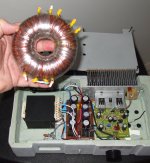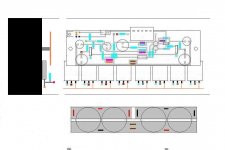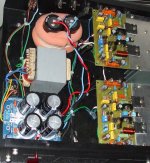Unstabilities, in the original Dx Blame ES (almost Blameless from Dr. Douglas Self)
was when i was injecting high frequencies (20 Khz) with high levels and square waves...over difficult loads, low impedance in the output, the capacitor to force unstabilities.
You know..square waves saturating, generating harmonics, above clipping or in the threshold of clipping.
This way the amplifier was in dangerous..usually fuses blow and something got burned...first VAS transistor or NPN driver use to burn..sometimes output gone too...i had a basket having dozen dead transistors inside....this never happened in my life, so many continuous burns...and i have insisted because my responsability with you, diy friends and Corporation builders..... crew man.
Usually, after 4 hours working, if the amplifier do not work fine, i use to abandon...to dismount, and to close the chapter.
High frequencies can happens if you use the amplifier together a mixer and a microphone....the microphone feedback (microfonia) can drive the amplifier to blow..also distorted guitars and samples using high output levels...or musical programs , the modern ones, where distortion is there in the music..
People can use the Dx Blame ES for years long and never face troubles....also i have used and have never faced troubles...but when you put it under test..low impedance loads, generator in the input...watching the scope screen, then we could see some strange things superimposed to the waveforms..we use to call oscilations..and triggered by the signal.
The last schematic, the Dx Blame ST, DOES NOT HAVE THESE ARTIFACTS, THOSE STRANGE SUPERIMPOSED SIGNALS.
regards,
Carlos
was when i was injecting high frequencies (20 Khz) with high levels and square waves...over difficult loads, low impedance in the output, the capacitor to force unstabilities.
You know..square waves saturating, generating harmonics, above clipping or in the threshold of clipping.
This way the amplifier was in dangerous..usually fuses blow and something got burned...first VAS transistor or NPN driver use to burn..sometimes output gone too...i had a basket having dozen dead transistors inside....this never happened in my life, so many continuous burns...and i have insisted because my responsability with you, diy friends and Corporation builders..... crew man.
Usually, after 4 hours working, if the amplifier do not work fine, i use to abandon...to dismount, and to close the chapter.
High frequencies can happens if you use the amplifier together a mixer and a microphone....the microphone feedback (microfonia) can drive the amplifier to blow..also distorted guitars and samples using high output levels...or musical programs , the modern ones, where distortion is there in the music..
People can use the Dx Blame ES for years long and never face troubles....also i have used and have never faced troubles...but when you put it under test..low impedance loads, generator in the input...watching the scope screen, then we could see some strange things superimposed to the waveforms..we use to call oscilations..and triggered by the signal.
The last schematic, the Dx Blame ST, DOES NOT HAVE THESE ARTIFACTS, THOSE STRANGE SUPERIMPOSED SIGNALS.
regards,
Carlos
Some Dx supplies to your fun.
Switching power supplies will enter protection mode when you do that.
ahahahahahaha!...not a good toy to be playing with.
http://www.youtube.com/watch?v=PW7jfHCuIbI
YouTube - Electronic supply load test 5A
YouTube - Dx voltage regulator, 5% instead of 28% losses.
YouTube - Dx Supply test II, 5% regulation, 350 Watts
Dx Corporation..the only one has audio visual aids for communication purposes.
regards,
Carlos
Switching power supplies will enter protection mode when you do that.
ahahahahahaha!...not a good toy to be playing with.
http://www.youtube.com/watch?v=PW7jfHCuIbI
YouTube - Electronic supply load test 5A
YouTube - Dx voltage regulator, 5% instead of 28% losses.
YouTube - Dx Supply test II, 5% regulation, 350 Watts
Dx Corporation..the only one has audio visual aids for communication purposes.
regards,
Carlos
Dx Corporation advertising, a diy free to build amplifiers, not a real business
The Dx Corporation is honored to say that their
products are extensively tested in order to anticipate,
predict, some misuse, inappropriate actions, carelessness,
distractions, intentional or destructive attitudes. pre anticipated,
bad nature people, having monstrous destructive character.. filled
with evil or ruthless.... for these ones we test extensively our
amplifiers, supplies and other circuits,in order to have
absolute certainty that they will survive in the hands of
more demanding people, as also, evil and destructive audiophiles.
Audio quality is important, also easy of construction, the follow up
to help builder is also very important..but the very first is reliabilty.
Dx Corporation Marketing Division, advertise number 32SP-04585734893-rr
The Dx Corporation is honored to say that their
products are extensively tested in order to anticipate,
predict, some misuse, inappropriate actions, carelessness,
distractions, intentional or destructive attitudes. pre anticipated,
bad nature people, having monstrous destructive character.. filled
with evil or ruthless.... for these ones we test extensively our
amplifiers, supplies and other circuits,in order to have
absolute certainty that they will survive in the hands of
more demanding people, as also, evil and destructive audiophiles.
Audio quality is important, also easy of construction, the follow up
to help builder is also very important..but the very first is reliabilty.
Dx Corporation Marketing Division, advertise number 32SP-04585734893-rr
Very nice Sound...... pretty one!
thank you to share the picture with us.
regards,
Carlos
thank you to share the picture with us.
regards,
Carlos
Attachments
Last edited:
The funny thing, Carlos,:
Volker is still (since more than a month) using the original BlameES.
Since he will build a new one (my whale-board does not fit very well into his ALU-enclosure) he is doing everything,
every torture he can imagine to make the BlameES fail.
He has bought an expensive, professional speaker protection circuit, measuring voltage, measuring DC fraction in the audio-signal,…,
so he is not afraid of breaking his speakers.
He operates the BlameES from a standard +37/-37 V power supply.
He is playing very, very loud, very “impressive” music (Linn records, samplers, …), especially high-frequency tracks,
auto-replay mode, playing hours and hours.
Nothing happens.
His BlameES (the original one) is playing like a rock.
And it sounds absolutely beautifully, top-notch, "wunderbar".
Even bass – not a shy one.
After reading the whole story and after listening to Volker's comments I am thinking to return to the original design.
And since I will not feed a 200 Khz square-wave into the inputs or feed-back a microphone I think that I will
have a big chance to hear some extraordinary sound as well.
Best regards - Rudi_Ratlos
Volker is still (since more than a month) using the original BlameES.
Since he will build a new one (my whale-board does not fit very well into his ALU-enclosure) he is doing everything,
every torture he can imagine to make the BlameES fail.
He has bought an expensive, professional speaker protection circuit, measuring voltage, measuring DC fraction in the audio-signal,…,
so he is not afraid of breaking his speakers.
He operates the BlameES from a standard +37/-37 V power supply.
He is playing very, very loud, very “impressive” music (Linn records, samplers, …), especially high-frequency tracks,
auto-replay mode, playing hours and hours.
Nothing happens.
His BlameES (the original one) is playing like a rock.
And it sounds absolutely beautifully, top-notch, "wunderbar".
Even bass – not a shy one.
After reading the whole story and after listening to Volker's comments I am thinking to return to the original design.
And since I will not feed a 200 Khz square-wave into the inputs or feed-back a microphone I think that I will
have a big chance to hear some extraordinary sound as well.
Best regards - Rudi_Ratlos
Yes Rudi, you will listen without troubles...normal music does not harm
the amplifier..some extreme uses are dangerous.
I also have used, for monthes (released December), without problems.
I found troubles watching the scope, when using generators plugged at the input, overdriving with square waves, and having difficult loads installed in the output.
Small video:
http://www.youtube.com/watch?v=K4q1frooUOk
regards,
Carlos
the amplifier..some extreme uses are dangerous.
I also have used, for monthes (released December), without problems.
I found troubles watching the scope, when using generators plugged at the input, overdriving with square waves, and having difficult loads installed in the output.
Small video:
http://www.youtube.com/watch?v=K4q1frooUOk
regards,
Carlos
Last edited:
The Blame eat this one (Dx Std) without make too much effort.
But even this way, the old and good Dx Standard sounds very nice too.
YouTube - Dx Amplifier - mic recording
regards,
Carlos
But even this way, the old and good Dx Standard sounds very nice too.
YouTube - Dx Amplifier - mic recording
regards,
Carlos
Post 1015 and 1016 dear Meanman....i see you have not time to read the thread
And this one is very small...... i hope you will find time to build.
The schematic, this final one, the Dx Blame ST, the most stable one!.... was not uploaded to Greg Erskine, because i am waiting Todd Johnson to find some time to change these things in his own lovely schematic.
So.... this is the reason why the update and upgrade is not in Greg Erskine pages...not to ask him to remove and to substitute by another one, professionally made, near future.
regards,
Carlos
And this one is very small...... i hope you will find time to build.
The schematic, this final one, the Dx Blame ST, the most stable one!.... was not uploaded to Greg Erskine, because i am waiting Todd Johnson to find some time to change these things in his own lovely schematic.
So.... this is the reason why the update and upgrade is not in Greg Erskine pages...not to ask him to remove and to substitute by another one, professionally made, near future.
regards,
Carlos
I think i have found one, between several reasons, made the Dx Blame ES
unstable...and this hell thing made me change a lot of things in my amplifier to face interferences i believe this one have generated.
The interferences, oscilations superimposed, have appeared in several amplifiers...even in the Destroyer Amplifier, the Standard and first one...i had in other amplifiers also, as Aksa 55, Symassym and DHR Turbo.
So, this explains the reason why folks had not troubles with their amplifiers...the main trouble was in my home...not inside their homes...they use to say the Dx Blame ES works fine and stable.
Maybe the transformer is the problem...removed, even the Dx Blame ES, the former one, had worked fine.
I would like to ask someone to explain me these things..if Toroidal transformers can do that, and also if you think i have a bad solder inside...or if i need to shield ...well..this is the first Toroidal transformer i have..... this is something very new to me....i tried several types of filters...but the transformer was the cause.
Maybe the entire Dx Blame ES unstability was because of this damned one!
regards,
Carlos
unstable...and this hell thing made me change a lot of things in my amplifier to face interferences i believe this one have generated.
The interferences, oscilations superimposed, have appeared in several amplifiers...even in the Destroyer Amplifier, the Standard and first one...i had in other amplifiers also, as Aksa 55, Symassym and DHR Turbo.
So, this explains the reason why folks had not troubles with their amplifiers...the main trouble was in my home...not inside their homes...they use to say the Dx Blame ES works fine and stable.
Maybe the transformer is the problem...removed, even the Dx Blame ES, the former one, had worked fine.
I would like to ask someone to explain me these things..if Toroidal transformers can do that, and also if you think i have a bad solder inside...or if i need to shield ...well..this is the first Toroidal transformer i have..... this is something very new to me....i tried several types of filters...but the transformer was the cause.
Maybe the entire Dx Blame ES unstability was because of this damned one!
regards,
Carlos
Attachments
If we are talking about transformers, I would always take the diodes into account too. Because they can do things (e.g. RF interference during switchoff), depending on their surrounding curcuitry.
So maybe you change the transformer, and see things are better now, and conclude from that, the transformer was the cause. But this does not have to be the whole story, as the diodes might be the origin of evil, but problems only occur e.g. in combination with a certain transformer, i.e a certain set of impedances around the diodes.
After all, how should a transformer cause oscillations directly?
I think it is the combination of it all, that can cause trouble. Change one thing and it may resolve the problem. But maybe changing another thing can be just as or even more effective.
regards,
krachkiste
So maybe you change the transformer, and see things are better now, and conclude from that, the transformer was the cause. But this does not have to be the whole story, as the diodes might be the origin of evil, but problems only occur e.g. in combination with a certain transformer, i.e a certain set of impedances around the diodes.
After all, how should a transformer cause oscillations directly?
I think it is the combination of it all, that can cause trouble. Change one thing and it may resolve the problem. But maybe changing another thing can be just as or even more effective.
regards,
krachkiste
A time ago I build an classe A amplifier and while I was adjusting the bias it was very hard to do.The bias was dancing so I measured my power inlet and it was going from 220 to 239 that could be a reason too.When I used my special regulated psu of Thel Audio I didn't had that problem.
Nice one Tinitus...thank you.....but folks!...the most interesting thing
is most of the troubles we face are simple things..and we use to tweak the amplifier, to include and remove capacitors and so on..... we never think in simple reasons, simple problem causes.
We never think an amplifier is not playing because the coaxial input cable is shorted inside.
We never think in the possibility, the chance we have inverted supply polarity...and things alike.
I have spent so many time tweaking the amplifier..when the transformer was the trouble.
I have runned three wires from the other supply, the one you see in the Dx 1000 years Reich enclosure (now a day it is gray).... i capture the AC wires..from the secondary..almost the same voltage..less than 10 percent difference..then i disconnect the toroidal transformer wires and then i installed those three wires that came from the black E/I standard transformer.... and problems... Disappeard...no more oscilations.... anything!>
So.... everybody, not only me...redesigning the amplifier..and suggestions came..do this!..do that!..others said the amplifier was not correct.... they said it would burn, this was wrong!, that was not perfect!..remove this!.... include that!.... increase this resistance!...reduce that other!....
ahahahahah!
The transformer was the trouble...but i could not understand the reasons..but for sure it was the trouble....so....in the reality, there's nothing wrong with the Dx Blame ES...exception is that 100 ohms resistance that must be substituted by 220 ohms (first VAS emitter resistance)
The Dx Blame ES is the best amplifier i have ever listened....so...i will return my schematic to "almost" the original..... the 220 ohms will be there, and will remove 470pf and will remove the 18pf too.
regards,
Carlos
is most of the troubles we face are simple things..and we use to tweak the amplifier, to include and remove capacitors and so on..... we never think in simple reasons, simple problem causes.
We never think an amplifier is not playing because the coaxial input cable is shorted inside.
We never think in the possibility, the chance we have inverted supply polarity...and things alike.
I have spent so many time tweaking the amplifier..when the transformer was the trouble.
I have runned three wires from the other supply, the one you see in the Dx 1000 years Reich enclosure (now a day it is gray).... i capture the AC wires..from the secondary..almost the same voltage..less than 10 percent difference..then i disconnect the toroidal transformer wires and then i installed those three wires that came from the black E/I standard transformer.... and problems... Disappeard...no more oscilations.... anything!>
So.... everybody, not only me...redesigning the amplifier..and suggestions came..do this!..do that!..others said the amplifier was not correct.... they said it would burn, this was wrong!, that was not perfect!..remove this!.... include that!.... increase this resistance!...reduce that other!....
ahahahahah!
The transformer was the trouble...but i could not understand the reasons..but for sure it was the trouble....so....in the reality, there's nothing wrong with the Dx Blame ES...exception is that 100 ohms resistance that must be substituted by 220 ohms (first VAS emitter resistance)
The Dx Blame ES is the best amplifier i have ever listened....so...i will return my schematic to "almost" the original..... the 220 ohms will be there, and will remove 470pf and will remove the 18pf too.
regards,
Carlos
I do not know Krachkiste!..... but i am sure it was the trouble.
When replaced the trouble finished..then i tried once again in other amplifier...and once again.... with the toroidal i had oscilations together the high frequencies (high level).... replacing the AC from the toroidal from the AC that came from the other transformer everything was fixed..... i also could not believe and i have repeated this several times...no doubts..was the transformer.
I have not tried to take it out from the enclosure (magnetic field)...but i will try that soon.... i have other transformer, and that one inside the enclosure...and no problems!...so..the suspection about that other transformer may be better because outside the enclosure is not correct.
You suggestion, the 18pf removal, really made the amplifier more stable..that one was not good..this is real..but only this removal could not fix...what fixed was the transformer substitution.
Observe the picture...another transformer...and the amplifier is rock stable...no problems.... it plays fine...no signal can unstabilize it anymore (18pf is out)...you see, even my Dx Supply was suspect..i have removed all snubbers and filters and the series coil bypassed...and nothing positive happened..the only way was to introduce another AC to the rectified...i have tried other rectifiers too...was not the rectifiers.... was the transformer....interesting... something new i am learning....
It is hard to me to believe..and i am the testimony what is happening...toroidal transformer working (the one..i have dismounted and mounted once again and will test it once again) and problems....no toroidal transformer working..then no problems!
It is very simple that way....hard to believe..but it is the truth....with the toroidal i have problems...disconnecting it and installing AC from other transformer secondary..(two tested) and the problem finishes.
Thank you Meanman, i have readed your post.
regards,
Carlos
When replaced the trouble finished..then i tried once again in other amplifier...and once again.... with the toroidal i had oscilations together the high frequencies (high level).... replacing the AC from the toroidal from the AC that came from the other transformer everything was fixed..... i also could not believe and i have repeated this several times...no doubts..was the transformer.
I have not tried to take it out from the enclosure (magnetic field)...but i will try that soon.... i have other transformer, and that one inside the enclosure...and no problems!...so..the suspection about that other transformer may be better because outside the enclosure is not correct.
You suggestion, the 18pf removal, really made the amplifier more stable..that one was not good..this is real..but only this removal could not fix...what fixed was the transformer substitution.
Observe the picture...another transformer...and the amplifier is rock stable...no problems.... it plays fine...no signal can unstabilize it anymore (18pf is out)...you see, even my Dx Supply was suspect..i have removed all snubbers and filters and the series coil bypassed...and nothing positive happened..the only way was to introduce another AC to the rectified...i have tried other rectifiers too...was not the rectifiers.... was the transformer....interesting... something new i am learning....
It is hard to me to believe..and i am the testimony what is happening...toroidal transformer working (the one..i have dismounted and mounted once again and will test it once again) and problems....no toroidal transformer working..then no problems!
It is very simple that way....hard to believe..but it is the truth....with the toroidal i have problems...disconnecting it and installing AC from other transformer secondary..(two tested) and the problem finishes.
Thank you Meanman, i have readed your post.
regards,
Carlos
Attachments
Last edited:
I am very surprised...but this happened..it is truth
a lot of hard work, frustrations, i have tried other amplifier because of that, and it turns absolutelly perfect only when i have replaced the transformer.... voltage was almost the same (10 percent differences plus to the black one and 10 percent less to the gray one).
regards,
Carlos
a lot of hard work, frustrations, i have tried other amplifier because of that, and it turns absolutelly perfect only when i have replaced the transformer.... voltage was almost the same (10 percent differences plus to the black one and 10 percent less to the gray one).
regards,
Carlos
This is very curious, indeed.
Still I would be carefull with drawing conclusions. (Allways!)
Especially the one that all torodials were bad and unusable for audio. (I don't think that is what you say, but i could get the impression, if I wanted)
We don't even understand yet, why the use of this your torodial causes trouble throughout all your designs.
It's an interesting fact, but solely blaming the xformer is not the only possible conclusion that could be drawn from that fact.
It would be important (to me) to understand, why this is the case, to reduce the set of possible conclusions, and build up a theory that explains all the facts.
Only a valid theory/model can lead to reliable predictions. (If it leads to one false prediction it is no longer valid).
So for example the theory, all torodials cause oscillations, would not be a valid one, as there are working amps out there using torodials and don't have trouble.
So, maybe there is something special going on with your torodial. Maybe there is something special with all the things you power up with it. And still it would be unclear what that special thing was.
If we knew that, we could make a prediction like, torodial T (having a known special property) and design D (having another known special property) will result in trouble if combined in way C.
regard,
krachkiste
Still I would be carefull with drawing conclusions. (Allways!)
Especially the one that all torodials were bad and unusable for audio. (I don't think that is what you say, but i could get the impression, if I wanted)
We don't even understand yet, why the use of this your torodial causes trouble throughout all your designs.
It's an interesting fact, but solely blaming the xformer is not the only possible conclusion that could be drawn from that fact.
It would be important (to me) to understand, why this is the case, to reduce the set of possible conclusions, and build up a theory that explains all the facts.
Only a valid theory/model can lead to reliable predictions. (If it leads to one false prediction it is no longer valid).
So for example the theory, all torodials cause oscillations, would not be a valid one, as there are working amps out there using torodials and don't have trouble.
So, maybe there is something special going on with your torodial. Maybe there is something special with all the things you power up with it. And still it would be unclear what that special thing was.
If we knew that, we could make a prediction like, torodial T (having a known special property) and design D (having another known special property) will result in trouble if combined in way C.
regard,
krachkiste
No, as you understood perfectly, i am not saying toroidal is good or bad
This one created me troubles..inside my enclosure, with this particular amplifier, in my home, in my weather..that unit...this one...not all toroidal transformers are problematic.
I was surprised....this is the first one i had ....and presented that.
We gonna see, how it will behave after i ressolder the one..... maybe bad solder..i have inspected for loosen wires, or broken insulator in transformer coils..nothing found..nothing strange..... i will try it distant from the amplifier, and them will be with it floating alike an helicopter searching for this bug.
This transformer, this particular, that unit..this one i have in my home is problematic, or was problematic..not all toroidal transformers.
regards,
Carlos
This one created me troubles..inside my enclosure, with this particular amplifier, in my home, in my weather..that unit...this one...not all toroidal transformers are problematic.
I was surprised....this is the first one i had ....and presented that.
We gonna see, how it will behave after i ressolder the one..... maybe bad solder..i have inspected for loosen wires, or broken insulator in transformer coils..nothing found..nothing strange..... i will try it distant from the amplifier, and them will be with it floating alike an helicopter searching for this bug.
This transformer, this particular, that unit..this one i have in my home is problematic, or was problematic..not all toroidal transformers.
regards,
Carlos
- Status
- Not open for further replies.
- Home
- Amplifiers
- Solid State
- Dx Blame ES .... based into the Blameless, i am trying a new amplifier
